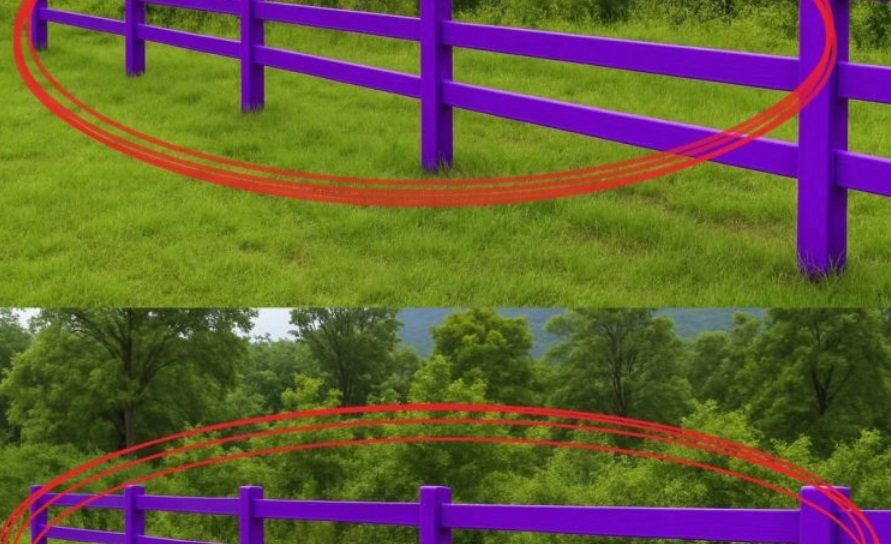If you’ve ever noticed a streak of purple paint on a tree or fence post while exploring rural areas, it’s not random decoration — it’s a legal warning. Across several U.S. states, purple paint marks are recognized as an official substitute for “No Trespassing” signs. Known as the Purple Paint Law, this regulation helps property owners clearly mark private land without constantly replacing damaged or missing signs.
What Is the Purple Paint Law?
The Purple Paint Law allows landowners to use specific paint markings instead of physical signage to signal “Private Property” or “No Trespassing.” It’s designed for large properties, wooded areas, and farmland where traditional signs might fall, fade, or get stolen.
The color purple was chosen for a practical reason — it’s highly visible, stands out in nature, and doesn’t blend in with the landscape. Over time, the paint holds up better than paper or metal signs, making it a cost-effective and durable option for rural property management.
How to Apply Purple Paint Legally
To be recognized under state trespassing laws, purple paint markings must follow clear legal standards. Random streaks don’t count — the paint must be applied correctly to serve as a valid warning.
Here are the general requirements most states follow:
- Shape: Vertical lines, not circles or smudges
- Size: At least one inch wide and eight inches long
- Height: Placed three to five feet above the ground so they’re visible but not hidden by grass or brush
- Spacing: Roughly every 100 feet along property boundaries to ensure visibility
These rules ensure that no one can cross private property without seeing at least one clear warning.
Which States Use the Purple Paint Law?
Not every state recognizes purple markings as a legal no-trespassing notice. However, the list is growing as more areas adopt this efficient approach to marking private property.
States that currently recognize the Purple Paint Law include:
- Texas
- Illinois
- Missouri
- North Carolina
- Kansas
- Florida
- Arkansas
- Louisiana
- Pennsylvania
In these states, a properly marked purple line carries the same legal weight as an official “No Trespassing” sign. However, laws can vary slightly from state to state, so it’s essential to verify your local property boundary regulations before painting.
Why Purple? The Color with Legal Power
Purple wasn’t chosen at random. It’s bright, uncommon in natural surroundings, and easy to recognize even from a distance. Unlike red or orange — which can be associated with other warnings — purple is distinctive and avoids confusion with trail markers or hunting signs.
Additionally, paint is weather-resistant, doesn’t require nails or posts, and doesn’t litter the landscape like broken signs might. For property owners, it’s an eco-friendly and practical alternative that saves time and money.
The Legal Meaning: What Purple Paint Communicates
Under no trespassing laws, a purple mark means exactly what a sign would say: “Do not enter.” Crossing a boundary marked with purple paint is treated as criminal trespassing in states where the law applies.
For hikers, hunters, or anyone exploring rural areas, this is an important visual cue. Seeing purple paint on trees or fences isn’t artistic expression — it’s a boundary backed by law. Ignoring it could lead to fines or trespassing charges.
Purple Paint and Property Owner Rights
The Purple Paint Law helps landowners protect their rights without constant maintenance. It also ensures consistent communication for anyone entering private property — from hunters to utility workers.
Using purple paint gives rural landowners a long-term, cost-effective way to mark their territory. It minimizes disputes, protects livestock, and reinforces privacy without the need for cluttered fencing or constant signage replacement.
What Hikers and Hunters Should Know
If you spend time outdoors, understanding property boundary markings is essential. When hiking, camping, or hunting, always watch for purple paint on trees, posts, or fences.
These marks are more than decoration — they serve as legal boundaries that you must not cross. Even if you don’t see a sign, the purple paint alone is enough to indicate restricted access. Respecting these markings helps avoid conflict with landowners and keeps you within the law.
The Broader Impact of the Purple Paint Law
Beyond its practical purpose, the Purple Paint Law reflects how states balance safety, privacy, and environmental awareness. Fewer plastic or metal signs mean less waste and visual pollution. The system also reduces maintenance costs for farmers, foresters, and private landholders.
It’s an example of how a small, consistent standard — a color and a few measurements — can streamline communication across large rural regions.
Key Takeaways
- Purple paint markings are a legal substitute for “No Trespassing” signs in many U.S. states.
- The marks must follow specific size, height, and spacing requirements to count legally.
- The law primarily benefits rural property owners, reducing the need for frequent sign replacement.
- Ignoring purple paint on fences or trees can result in trespassing charges where the law is recognized.
- Always check state or local laws before applying or interpreting purple markings.
Final Thoughts
A single stripe of color can carry a powerful message. The Purple Paint Law turns a simple hue into a symbol of privacy, safety, and respect for boundaries.
So, the next time you spot a violet or plum streak on a tree trunk or fence post, remember: it’s not random art. It’s a quiet legal statement — a visual warning that says, this is private property; you’ve gone far enough.




